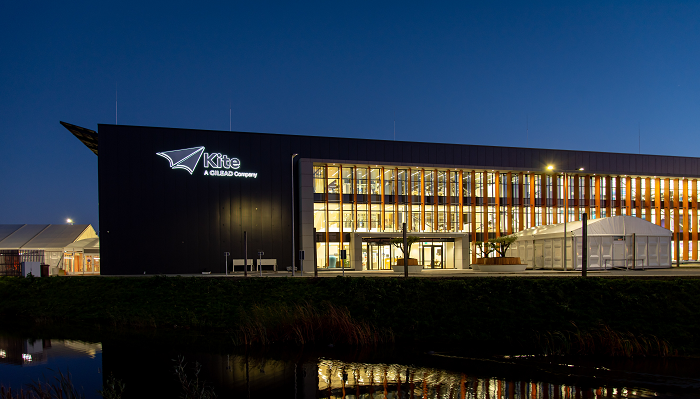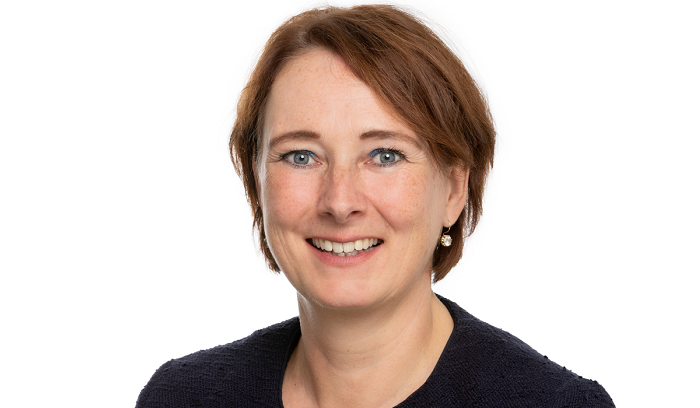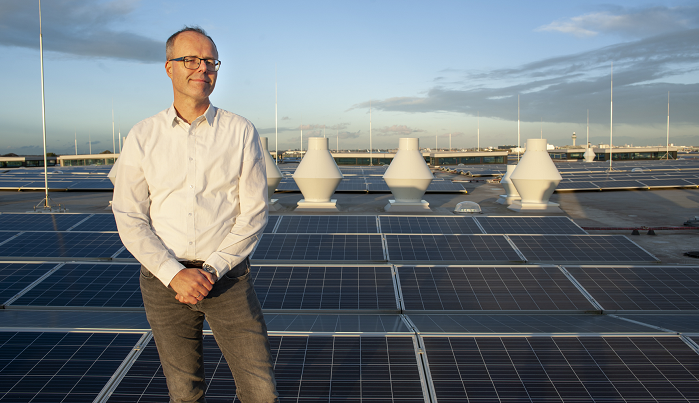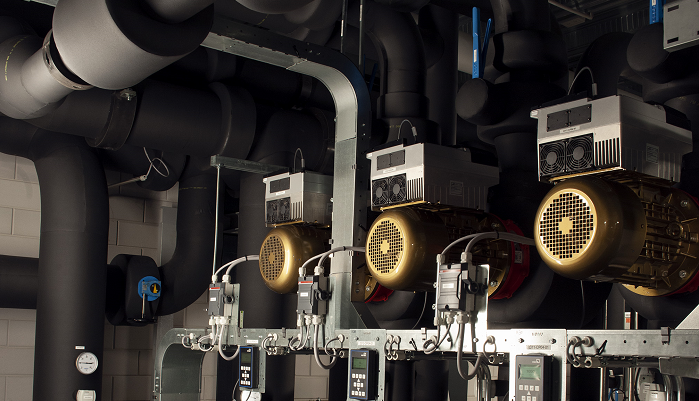17 January 2022
Biotech company Kite, a Gilead Sciences company, with headquarters in California, USA, recently opened its first net-zero carbon manufacturing facility, in Hoofddorp. Kite produces cell therapy, an innovative, individualised treatment for people with certain types of blood cancer. The company’s ‘green’, 100% sustainably operated building, is truly a showcase project for building future facilities. We spoke to Karen Vink, Director Public Affairs, and Henk Wolf, Senior Manager Environment, Health & Safety, about the importance for Kite to be environmentally friendly.

Why is sustainability so important to Kite?
Karen: We really want to make a positive impact. Not only on the lives of patients - with cell therapy, which is the treatment we are focussing on, but also on society. We believe that it is necessary to minimize the effect of our production process on the environment, and we want to lower our consumption of natural resources, as much as possible. That’s why we carefully designed our brand new 19.000m2 European manufacturing facility, from the perspective of reducing our carbon footprint. We aim to only use sustainable energy and recycle, as much as possible.

Kite is growing rapidly and is recruiting many new staff members. Is sustainable operation also an advantage for recruitment in this tight labour market?
Karen: Oh yeah, absolutely. First of all; cell therapy, is a relatively new, innovative and highly individualised way to treat patients with specific types of blood cancer, for whom other treatments have failed. This in itself, attracts highly motived people, with a social conscience, from all over the world. Furthermore, we can see that, particularly millennials, have strong valuation for the concept of sustainability. And it is important to be aware of that, since it sets us apart from other biotech companies. We are growing rapidly, with 20 to 30 new colleagues being recruited a month. And to keep up with our pace of growth, we especially wish to attract this group of highly skilled, idealistic young people. They are eager to do pioneering work as Cell Therapy Specialists, in our manufacturing department.
What makes the Kite building in Hoofddorp so special?
Henk: Our new Kite facility in Hoofddorp, is the first net-zero carbon building in the network of all Kite and Gilead facilities globally. This means that all the power we use for our operations is produced via sustainable sources.
“The Kite building is operated with 100% renewable energy”
What does a net-zero carbon building look like?
Karen: Well, I know I’m biased, but I think it’s beautiful. Originally, before we moved in, the building was already BREEAM certified. BREEAM is a leading sustainability assessment method to assess the sustainability performance of real estate. When we entered this building, it was an empty space designed specifically with the environment in mind. In just two years, we brought in all the infrastructure and equipment that was needed to operate, selecting only materials, like walls and windows, that were extremely well insulated.
Furthermore, our new facility was not meant to have any fossil fuel connection. From the beginning, the plan was to run the building exclusively with sustainable energy. For businesses like ours, this is very unusual. But we did it. So, we now have a 100% ‘green’ operated building.
Where do you get the energy from?
Henk: We installed 1,800 solar panels on the roof, to get energy from sunlight. This significant number of solar cells produces power for an equivalent of about 100 households. We collaborated with highly competent local contractors to install these solar panels, in a very short amount of time.
“We only buy green energy from European providers.”
1,800 solar panels, that sounds like a lot!
Henk: It is a lot. However, with 19,000 square meters, our building is large – and, as we are running operations around the clock, following a twenty-four-seven schedule, our need for energy is substantial. To give you an example; we are continuously cleaning the air in our clean rooms, as well as controlling the temperature and humidity of these areas. Although, our solar panels generate a substantial amount of energy, we need more to be able to operate, especially in winter. Therefore, we have chosen to purchase additional electricity, from natural sources only, provided exclusively by European suppliers. Consequently, by buying power marked with European certificates, we make sure that it is produced solely via wind and solar.

What else is your company doing in the attempt to be sustainable?
Henk: Alongside solar panels we have utilized many more technical solutions. For instance, we installed heat pumps, with which we store heat, collected over summer, in an underground water layer. In winter, we use this, to support heating our building. Another example: LED lighting is used throughout the whole building and automatically switches off when there is nobody in the office area. Additionally, we incorporated high tech air handling and ventilation systems, which collects heat from the ventilated air.

Karen: It is a rare opportunity to be able to start from scratch. So, we feel privileged that we had this chance to build our facility in an empty shell. It allowed us to be proactive from the beginning and install all these features that are so state-of-the-art environmentally friendly. With this up to the minute design, we are confident and ready for an exciting and productive future.
“I am proud that we have achieved a substantial amount of waste recycling in our facility.”
You told me about your efforts to recycle. What are these efforts about?
Henk: We introduced a program to limit, reduce and recycle the waste of our operation. Within Kite, many departments generate it, just by the nature of their functioning. However, two years ago, when we started our operations for Europe in Hoofddorp, we had only three streams: residual, hospital and other waste. Now we can separate this into multiple categories, of which most is currently recycled, safeguarding valuable natural resources and costs.
Do you work with local partners in recycling?
Henk: We have collaborations with partners in the area, with whom we conduct audits on a regular basis. We jointly walk through the whole building, looking at different waste streams and making staff aware of the recycling opportunities. Of course, it is a step-by-step process, but we have really made a difference so far. Not only in the office space, but also in the production area. It is a serious challenge to separate waste in highly regulated areas such as cleanrooms. Nevertheless, by working closely with all departments involved, making them aware of what they can do themselves, and inviting them to think along, this recycling is becoming a reality.
What are the future plans?
Karen: In the near future, we expect to increase our production capacity even further, to meet the European demand for cell therapy. Therefore, we will expand our new facility and recruit even more staff. Consequently, as we will need more energy, we will keep on looking for further ways to become even more sustainable. And the knowledge and expertise we gained so far, will absolutely be included in future expansions.

